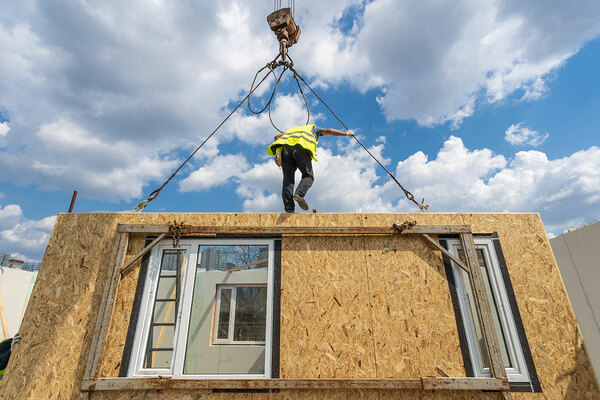You are viewing 1 of your 1 free articles
A challenge to the sector on zero carbon
The sector is stuck in the past in its approach to decarbonisation, argues Tom Jarman. The government has virtually no interest in a discussion about regulation and subsidy
During the course of this year, decarbonising existing homes has been discussed with increasing frequency and urgency. It’s not without good cause; there are more than 24 million homes in England alone, and using those in bands G to D as a guide, some two-thirds will need retrofitting by 2050.
That’s more than 11,000 homes a week, if you start in January 2021. The proportion of these in social housing is lower due to the consistently high level of investment in stock condition but is nonetheless over 1.75 million homes or about 1,200 a week.
“As a sector, if we don’t have the determination, capacity and capability to define a common and ambitious retrofit standard, then we are in real trouble”
So far, so alarming. But it isn’t the numbers that I want to draw attention to, but the culture in which we are deciding the fate of those 1.75 million homes.
I started working in social housing in 2005, and by 2010 it was obvious to me that decarbonisation of existing homes was coming our way. The discussion then was about regulation (what standards would the sector need to retrofit to by when?) and it was about subsidy: it’s very expensive, the financial gap looks like this, therefore that’s the level of grant we need.
The problem for the sector is that the debate has moved on, but our narrative hasn’t. I know a counterpoint is that a common standard is needed to organise around, and regulation is the most effective way to create a common standard. But I think this betrays the poverty of our thinking. As a sector, if we don’t have the determination, capacity and capability to define a common and ambitious retrofit standard, then we are in real trouble.
It is true that regulation drives the underlying standard to which supply chains will invest and deliver, but they will also invest, skill up and innovate to the level that clients consistently demand and they’ll probably do it better.
“The government wants to talk about value, outcome and productivity. It virtually has no interest in a discussion about regulation and subsidy”
Second, regulation doesn’t speak to an absolutely critical issue. How do we carry out retrofit which performs safely to a high standard and does this consistently over time? Retrofit is risky, and there are many examples of where it has made housing worse and put occupants’ health in danger.
The key risk-mitigation measures are an effective, outcome-focused client culture, skilled and resilient supply chains, and technical teams that are obsessed with value, outcome, risk, performance and quality. Regulation can’t effectively manage this risk for us and it won’t create an effective client culture on our behalf.
Which brings us to subsidy. Have you heard the joke about the politician and the butter*? The government has the butter and it wants to talk about value, outcome and productivity. It virtually has no interest in a discussion about regulation and subsidy.
Furthermore, since 2010, we have spent some £150bn on new supply and repairs and maintenance. This is the most enormous missed opportunity to demonstrate our transformative potential, create momentum and weight, and show client leadership. If we can’t do this for ourselves, is it any wonder that the government has shown reluctance to really engage?
“We have wasted years having a tired, familiar discussion with ourselves. We know roughly what good decarbonisation looks like, let’s harness this and focus on what the sector does next to turn this into reality”
The tragedy is that we are a sector with enormous transformative potential: we are relatively unified, we are a significant construction client, our investment intent is more sophisticated than compliance at lowest capital cost and we operate assets over the long term. But we need to be much clearer about what we can transform and unlock.
If you haven’t read Transforming Infrastructure Performance or Construction Sector Deal, read them as they will tell you where government thinking is now and are templates for the discussions we should be having. If don’t know what the Construction Innovation Hub is and haven’t heard of the Value Toolkit, then you need to get linked in to their work urgently, because that’s where the most powerful department, the Treasury, is. This is a direction of travel with traction and momentum.
Housing wasn’t one of the five departments in the 2017 Presumption in Favour of Offsite group, so we need to ask why because that says much about the perception of the sector as a partner for transformation. Until we change this perception, we’ll remain outside the core narrative. This is a loss for us and government, but I suspect it’s a greater loss for the people that live in older, colder social housing. We owe it to them to come out of our comfort zone.
An effective retrofit programme is our natural home, given the range of benefits it can deliver and the linkage with our social mission. But we have wasted years having a tired, familiar discussion with ourselves. We know roughly what good decarbonisation looks like, let’s harness this and focus on what the sector does next to turn this into reality.
But let’s start with what we can do. As construction clients, we are transformative agents – isn’t that much more exciting, energising and renewing than a place in the long, slow-moving queue marked regulation and subsidy?
*The butter joke…
A senator is in a restaurant and the waiter brings over the rolls, but no butter. “May I have some butter, please?,” asks the senator. The waiter gives a slight nod and wanders off.
Ten minutes later, still no butter. The senator catches his eye and says: “May I have some butter, please?”
Still the vaguest of responses and after 10 more minutes, still no butter.
“Maybe you don’t know who I am,” says the senator. “I’m a Princeton graduate, a Rhodes scholar, an All-American basketball player who played with the New York Knicks in the pros; and I’m currently a United States senator, chairman of the International Debt Sub-committee of the Senate Finance Committee, chairman of the Water and Power Subcommittee of the Senate Energy and Natural Resources Committee, and a member of the Senate Select Intelligence Committee.”
“Maybe you don’t know who I am,” said the waiter. “I’m the guy who’s in charge of the butter.”
Tom Jarman, director, Low Carbon Journey













